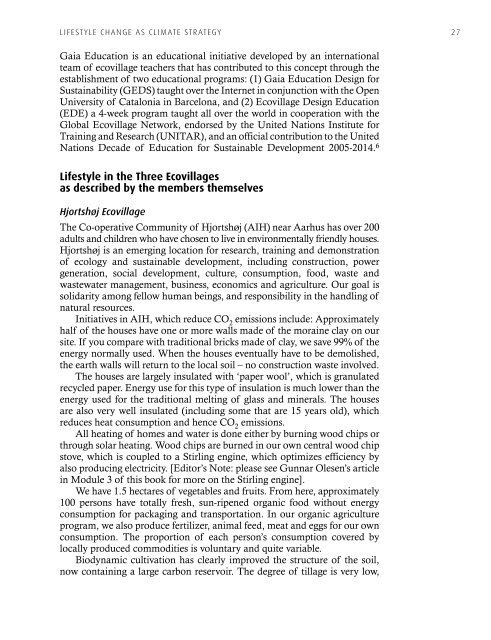Designing Ecological Habitats - Gaia Education
Designing Ecological Habitats - Gaia Education
Designing Ecological Habitats - Gaia Education
You also want an ePaper? Increase the reach of your titles
YUMPU automatically turns print PDFs into web optimized ePapers that Google loves.
lifestyle cHange as climate strategy 27<br />
<strong>Gaia</strong> <strong>Education</strong> is an educational initiative developed by an international<br />
team of ecovillage teachers that has contributed to this concept through the<br />
establishment of two educational programs: (1) <strong>Gaia</strong> <strong>Education</strong> Design for<br />
Sustainability (GEDS) taught over the Internet in conjunction with the Open<br />
University of Catalonia in Barcelona, and (2) Ecovillage Design <strong>Education</strong><br />
(EDE) a 4-week program taught all over the world in cooperation with the<br />
Global Ecovillage Network, endorsed by the United Nations Institute for<br />
Training and Research (UNITAR), and an official contribution to the United<br />
Nations Decade of <strong>Education</strong> for Sustainable Development 2005-2014. 6<br />
Lifestyle in the Three Ecovillages<br />
as described by the members themselves<br />
Hjortshøj Ecovillage<br />
The Co-operative Community of Hjortshøj (AIH) near Aarhus has over 200<br />
adults and children who have chosen to live in environmentally friendly houses.<br />
Hjortshøj is an emerging location for research, training and demonstration<br />
of ecology and sustainable development, including construction, power<br />
generation, social development, culture, consumption, food, waste and<br />
wastewater management, business, economics and agriculture. Our goal is<br />
solidarity among fellow human beings, and responsibility in the handling of<br />
natural resources.<br />
Initiatives in AIH, which reduce CO2 emissions include: Approx imately<br />
half of the houses have one or more walls made of the moraine clay on our<br />
site. If you compare with traditional bricks made of clay, we save 99% of the<br />
energy normally used. When the houses eventually have to be demolished,<br />
the earth walls will return to the local soil – no construction waste involved.<br />
The houses are largely insulated with ‘paper wool’, which is granulated<br />
recycled paper. Energy use for this type of insulation is much lower than the<br />
energy used for the traditional melting of glass and minerals. The houses<br />
are also very well insulated (including some that are 15 years old), which<br />
reduces heat consumption and hence CO2 emissions.<br />
All heating of homes and water is done either by burning wood chips or<br />
through solar heating. Wood chips are burned in our own central wood chip<br />
stove, which is coupled to a Stirling engine, which optimizes efficiency by<br />
also producing electricity. [Editor’s Note: please see Gunnar Olesen’s article<br />
in Module 3 of this book for more on the Stirling engine].<br />
We have 1.5 hectares of vegetables and fruits. From here, approximately<br />
100 persons have totally fresh, sun-ripened organic food without energy<br />
consumption for packaging and transportation. In our organic agriculture<br />
program, we also produce fertilizer, animal feed, meat and eggs for our own<br />
consumption. The proportion of each person’s consumption covered by<br />
locally produced commodities is voluntary and quite variable.<br />
Biodynamic cultivation has clearly improved the structure of the soil,<br />
now containing a large carbon reservoir. The degree of tillage is very low,







